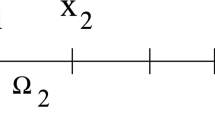Abstract
Pseudo spectral methods offer an attractive alternative to finite element procedures for the solution of problems in elasticity. Especially for simple domains, questions involving both two and three dimensional elasticity (Navier’s Equations or their non-linear generalisations) would seem to be reasonable candidates for a pseudo spectral approach. This paper examines some simple vibrational eigenvalue type problems, demonstrating how Navier’s equations can be recast into pseudo- spectral format, including first derivative boundary conditions representing zero traction. Fourier–Chebyshev methods are shown to give solutions with typical spectral accuracy, with the addition of pole conditions being necessary for the case of a two dimensional disc. There is also consideration given to time-stepping solutions of elastodynamic problems, especially those involving non-linear friction effects, the authors particular interest being the study of disc brake noise. It is shown that, at least for relatively simple cases, it is possible to model systems in such a way that animated graphical output can be provided as the system of partial differential equations is numerically integrated. This provides a useful tool for engineers to rapidly examine the effect of parameter changes on a system model.
Similar content being viewed by others
References
Chen H., Su Y., and Shizgal B.D. (2000). A direct spectral collocation Poisson solver in polar and cylindrical coordinates. J. Comput. Phys. 160:453–469
Eringen A.C., and Suhubi, E.S. (1975). Elastodynamics Vol. II Academic Press.
Fornberg B. (1987). The pseudospectral method: comparisons with finite differences for the elastic wave equation. Geophysics 52:483–501
Fornberg B. (1988). The pseudospectral method: accurate representation of interfaces in elastic wave calculations. Geophysics 53:625–637
Fornberg, B. (1996). A Practical Guide to Pseudospectral Methods, Cambridge University Press
Huang W., and Sloan D.M. (1993). Pole conditions for singular problems: the pseudospectral approximation. J. Comput. Phys. 107:254–261
Mason J.C., and Handscomb D.C. (2003). Chebyshev Polynomials – Theory and Applications. Chapman and Hall, CRC Press, London
Peyret, R. (2002). Spectral Methods for Incompressible Viscous Flow, Springer.
Pilipchuk V.N., Ibrahim R.A., and Blaschke P. (2002). Disc brake ring-element modelling involving friction-induced vibration. J. Vib. Control 8:1085–1104
Talbot, C.J., and Crampton, A. Application of the pseudo-spectral method to 2d eigenvalue problems in elasticity. J. Numer. Algorithms. Special Issue: Chebyshev Polynomials. To appear.
Tessmer E., and Kosloff D. (1994). 3-D elastic modeling with surface topography by a Chebyshev spectral method. Geophysics 59:464–473
Trefethen, L. N. (2000). Spectral Methods in MATLAB, SIAM
Author information
Authors and Affiliations
Corresponding author
Rights and permissions
About this article
Cite this article
Talbot, C., Crampton, A. Pseudo Spectral Methods Applied to Problems in Elasticity. J Sci Comput 27, 443–454 (2006). https://doi.org/10.1007/s10915-005-9028-x
Received:
Accepted:
Published:
Issue Date:
DOI: https://doi.org/10.1007/s10915-005-9028-x




